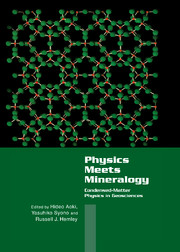Book contents
- Frontmatter
- Contents
- Preface
- List of Contributors
- Part I Introduction
- Part II Advances in Theoretical and Experimental Techniques
- Part III New Findings in Oxides and Silicates
- Chapter 3.1 Search for a Connection Among Bond Strength, Bond Length, and Electron-Density Distributions
- Chapter 3.2 MgO – The Simplest Oxide
- Chapter 3.3 First-Principles Theoretical Study of the High-Pressure Phases of MnO and FeO: Normal and Inverse NiAs Structures
- Chapter 3.4 Computer-Simulation Approach to the Thermoelastic, Transport, and Melting Properties of Lower-Mantle Phases
- Part IV Transformations in Silica
- Part V Novel Structures and Materials
- Part VI Melts and Crystal–Melt Interactions
- Subject Index
- Materials Formula Index
- Index of Contributors
Chapter 3.3 - First-Principles Theoretical Study of the High-Pressure Phases of MnO and FeO: Normal and Inverse NiAs Structures
Published online by Cambridge University Press: 05 November 2011
- Frontmatter
- Contents
- Preface
- List of Contributors
- Part I Introduction
- Part II Advances in Theoretical and Experimental Techniques
- Part III New Findings in Oxides and Silicates
- Chapter 3.1 Search for a Connection Among Bond Strength, Bond Length, and Electron-Density Distributions
- Chapter 3.2 MgO – The Simplest Oxide
- Chapter 3.3 First-Principles Theoretical Study of the High-Pressure Phases of MnO and FeO: Normal and Inverse NiAs Structures
- Chapter 3.4 Computer-Simulation Approach to the Thermoelastic, Transport, and Melting Properties of Lower-Mantle Phases
- Part IV Transformations in Silica
- Part V Novel Structures and Materials
- Part VI Melts and Crystal–Melt Interactions
- Subject Index
- Materials Formula Index
- Index of Contributors
Summary
The phase stability of transition-metal monoxides MnO and FeO under ultrahigh pressure, which reaches the range in the Earth's lower mantle, was studied with the first-principles calculations based on density function theory. The plane-wave basis pseudopotential method was used to perform the structure optimization efficiently, and the electron–electron interaction was treated by the generalized gradient approximation (GGA) supplemented by the LDA + U method (LDA is local-density approximation). Two related structures, normal NiAs (nB8) and inverse NiAs (iB8) types, are emphasized. Our results predict that the high-pressure phase of MnO should take the nB8 structure rather than the CsCl (B2) structure and that a metastable nonmagnetic Bl structure can be realized for MnO in the intermediate pressure range. A very unique iB8 structure rather than the nB8 structure is predicted as the high-pressure phase of FeO, although no materials have ever been known to take the iB8 structure. The novel feature of the iB8 FeO is that the system should be a band insulator in the antiferromagnetic state and that the existence of a bandgap leads to special stability of the phase. The larger c/a ratios for both nB8 MnO and iB8 FeO were explained based on our analysis of the cation radius-anion radius ratios versus c/a for series of similar materials.
Introduction
The high-pressure phases of metal monoxides [including alkaline-earth-metal monoxides, transition-metal monoxides (TMMOs), etc.], with the rock-salt (Bl) structure at normal pressure and room temperature, are important for both condensed-matter physics and earth science because their crystal structure is simple and moreover MgO and FeO are considered to be important constituents of the Earth's deep mantle.
- Type
- Chapter
- Information
- Physics Meets MineralogyCondensed Matter Physics in the Geosciences, pp. 124 - 142Publisher: Cambridge University PressPrint publication year: 2000



